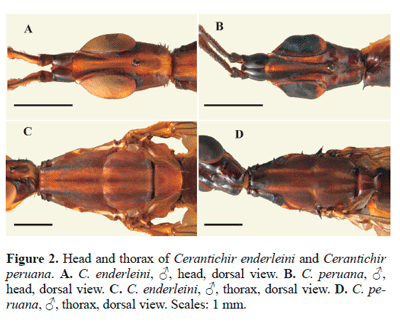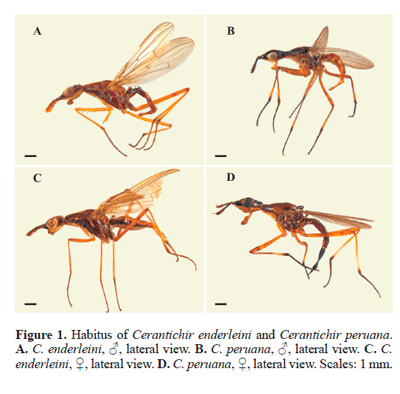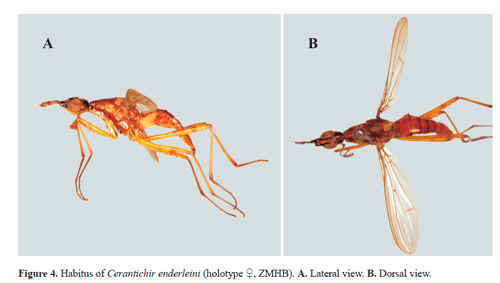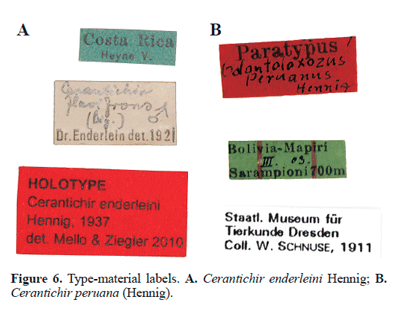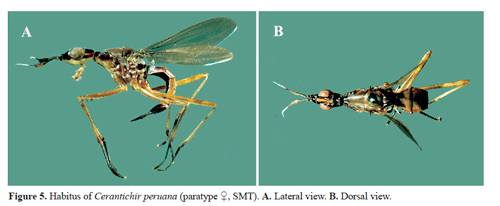Services on Demand
Journal
Article
Indicators
-
 Cited by SciELO
Cited by SciELO -
 Access statistics
Access statistics
Related links
-
 Cited by Google
Cited by Google -
 Similars in
SciELO
Similars in
SciELO -
 Similars in Google
Similars in Google
Share
Revista Colombiana de Entomología
Print version ISSN 0120-0488
Rev. Colomb. Entomol. vol.39 no.1 Bogotá Jan./June 2013
Revision of the neotropical genus Cerantichir (Diptera: Neriidae) with new records and a key to species
Revisión del género neotropical Cerantichir (Diptera: Neriidae) con nuevos registros y clave de especies
TATIANA A. SEPÚLVEDA1,2, ALESSANDRE PEREIRA-COLAVITE2 and CLAUDIO J. B. DE CARVALHO2
1 Grupo de Entomología, Universidad de Antioquia, apartado aéreo 1226, Medellín, Colombia.
2M. Sc., M. Sc. and Ph. D. respectively. Department of Zoology, Universidade Federal do Paraná, postal box 19020, 81531-980, Curitiba, Paraná, Brazil. Corresponding autor: T. A. S. tatasevilla@gmail.com; A. P. C. neneco@gmail.com; C. J. B. C. cjbcarva@gmail.com.
Abstract: The Neotropical “cactus fly" genus Cerantichir is revised. New information on morphology and distribution is provided. New diagnosis, redescriptions and a key to identification of the two currently known species, along with photographs and illustrations.
Key words: Biodiversity. Cactus fly. New records. Taxonomy.
Resumen: Se revisó el género Neotropical de “moscas del cactus" Cerantichir y se presenta nueva información sobre morfología y distribución. Se incluye una nueva diagnosis, redescripción y clave para la identificación de las dos especies actualmente conocidas, así como fotografías e ilustraciones.
Palabras clave: Biodiversidad. Moscas del cactus. Nuevos registros. Taxonomía.
Introduction
The Neriidae comprise a small family of acalyptrate flies, with 110 species in 19 genera (Steyskal 1965, 1968, 1977, 1980; Soós 1984; Mangan and Baldwin 1986; Pitkin 1989; Barraclough 1993; Buck and Marshall 2004). While these flies are found in all biogeographic regions, they tend to predominate in the tropics (Steyskal 1968, 1987). All neriids feed on sap and decaying plant tissues (Aczél 1961; Steyskal 1987; Buck 2010).
The genus Cerantichir Enderlein, 1922 comprises two species, C. enderleini Hennig, 1937 and C. peruana (Hennig, 1937) that occur in the neotropics from Guatemala to the Midwestern Brazil. Originally, the genus was proposed by Enderlein to include Nerius flavifrons Bigot, 1886, removed from Nerius based on the presence of the following characters: (1) arista dorso-apical and pubescent, (2) flagellomere with truncate apex, (3) long finger-like inner process of the pedicel, (4) fore legs with ventral spine-like setae towards the apex, (5) scutellum with two setae in tubercles and (6) vein dm-cu short and perpendicular (Enderlein 1922).
Hennig (1937) reviewed the genus Cerantichir in which C. flavifrons Enderlein nec Bigot was called C. enderleini. He defined the genus as having (1) the apex of flagellomere ovate, (2) arista subapical with white pubescence, (3) one upper orbital, paravertical, weak inner and outer vertical setae, (4) a palpus broad at the base and pointed forward, (5) a thorax moderately extended, (6) a scutellum with slightly S-shaped curved edges, (7) one dorsocentral, one supra-alar, one postalar and one scutellar setae, all weak, (8) a weak anterior and a b posterior notopleural setae, (9) mid and hind femora with spine-like anteroventral and posteroventral setae and (10) dm-cu slightly convex. Aczél (1961) defined the genus only by (1) pedicel elongate in both sexes, (2) anterior notopleural seta reduced (hair-like) and posterior notopleural seta conspicuous and (3) dm-cu straight, not oblique.
Recently, Buck (2010) stated that the Cerantichir have (1) anterior margin of frons at most weakly convex, not produced between antennal bases, (2) proepisternum anterodorsally bare, (3) scutum anteriorly projected distinctly beyond level of humeral carina, (4) antepronotal ridge prominent and distinctly placed anterior to humeral carina and (5) dm-cu not oblique, bly diverging from wing hind margin. Based on the shared apomorphic condition of the anterior part of the thorax, Buck (2010) transferred Odontoloxozus peruanus Hennig, 1937 to Cerantichir, but this character is also shared with Longina Wiedemann. Other characters, such as the number 1, 2 and 5 (see above) do not fits with the species newly transferred to the genus and may be easily confused with characters of Longina, except for the word “distinctly", describing the projected scutum.
In addition, Buck and Marshall (2004) emphasized that the similarities shared by these genera may suggest a “possible monophylum" Longina+Cerantichir, and Buck (2010) questioned the validity of some Neotropical genera of Neriidae and suggested that the genera need to be critically evaluated. Thus, in order to start this critical evaluation, we are presenting a detailed redescription of Cerantichir (Longina has been studied in detail; Buck and Marshall 2004), as well as a new diagnosis for the genus. New records along with an identification key that is based on adult morphological characters are also presented.
Material and methods
The specimens examined are deposited in the following institutions: Coleção Entomológica Padre Jesus Santiago Moure (DZUP), Curitiba, Brazil; Instituto Nacional de Biodiversidad (INBio), Santo Domingo de Heredia, Costa Rica; Colección Entomológica de la Universidad de Antioquia (CEUA), Medellín, Colombia; Instituto Alexander von Humboldt (IAvH), Villa de Leyva, Colombia and Colección Entomológica del Instituto y Fundación Miguel Lillo (IFML), Tucumán, Argentina. We also examined photographs of type-material obtained from the Museum für Naturkunde, Humboldt-Universität, Berlin, Germany (ZMHB) and the Staatliches Museum für Tierkunde, Dresden, Germany (SMT).
The material was examined using a Zeiss Stemi DV4 stereoscopic microscope. Photographs were coupled with the Auto-Montage Imaging System®. Drawings and photos were edited using Adobe Illustrator CS5.1 and Adobe Photoshop CS5. The terminology and descriptions of the position of setae follow Cumming and Wood (2009).
The following abbreviations are used in the text: cat. = catalogue; comb. n. = new combination; excl. = excluding; fig./figs. = figure/figures; misid. = misidentification; nom. n. = nomen novum; orig. des. = by original designation; pp. = pages; pls = plates.
Taxonomy
Cerantichir Enderlein Enderlein 1922: 149 (key), 155 (description; Nerius flavifrons Bigot, 1886b orig. des., misid.); Cresson 1930: 314 (listed, = Nerius); Hennig 1937: 244 (key), 256 (redescription); Aczél 1949: 379 (cat.); Aczél 1951: 569 (key); Aczél 1961: 298 (genus conspectus); Steyskal 1965: 637 (cat., = Oncopsia); Steyskal 1968: 1 (cat.); Buck 2010: 818 (key), 819 (synopsis of the fauna).
Diagnosis. Fronto-orbital plate shiny wide. Ocellar tubercle large, raised and blackish velvety (Figs. 2A-2B). Outer vertical setae absent. Vibrissa absent. Postgena shiny and relatively narrow and either bare or with a few several black setulae. Occiput shiny elongate and as long as high (Fig. 3C). Pedicel laterally flattened, scape less than half of pedicel length; arista densely white pubescent, except for the small basal portion brown pubescent. Thorax elongate, with mesoscutum and antepronotal ring distinctly anterior to postpronotal carina (Fig. 3C); anterior margin with two setae. Anterior margin of prosternum wide and truncated. One pair of dorsocentral setae (Figs. 2C-2D). Wing partially covered by microtrichia; basally has small bare areas (extending beyond level of r-m in cells r1, r2+3 and r4+5). Scutellum with one pair of stout apical setae and two weaker subapical setae. Epandrium extends to level of anterior margin (at most) of tergite 4.
Distribution. Guatemala, Costa Rica, Colombia, Brazil, Peru, Bolivia (Fig. 7).
Key to adults of Cerantichir Enderlein
Antennal base dorsally longer than wide; inner margins separated by a small space (Fig. 2A). Inner process of pedicel elongate, finger-like, reaching the proximal half of flagellomere (Fig. 3A). Apex of flagellomere widely rounded. Occiput with black setae towards posterior head margin (Fig. 2A).............................................................................. C. enderleini
Antennal base rounded and inflated; inner margins together, with no space between them (Fig. 2B). Inner process of pedicel obtuse with widely rounded apex and extending over a very short proximal portion of the flagellomere (Fig. 3B). Apex of flagellomere truncate. Occiput without black setae towards posterior head margin (Fig. 2B) C. peruana
Cerantichir enderleini Hennig, 1922 Figs. 1A, 1C, 2A, 2C, 3A, 3D, 3F-3H, 4A-4B, 6A
Cerantichir flavifrons Enderlein, 1922: 155 (type-species Nerius flavifrons Bigot, 1886, orig. des.; misid.).
Cerantichir enderleini Hennig 1937: 256 (nom.n. to Cerantichir flavifrons Enderlein, 1922, not Nerius flavifrons Bigot, 1886); Aczél, 1949: 379 (cat.); Aczél, 1951: 569 (key); Aczél, 1961: 263-275 (genus, morphological aspects), 277 (key), 299 (redescription), 303 figs. 28-31 (28. male, head, lateral view; 29. male, head, dorsal view; 30. female, antennae, inner process; 31. male, fore femur, lateral view); Steyskal 1968: 2 (cat.); Buck, 2010: 816 fig. 2 (head (antennae excluded) and anterior part of thorax, lateral view). Mello and Ziegler 2012: 152 (cat., type-material).
Male. Body length (excluding antenna and epandrium) 8.6-12.8 mm (Fig. 1). Wing length 7.5-9.4 mm and width 2.1-2.7 mm. Yellowish brown, head partly yellow and shiny; pleuron shiny yellowish brown and bare; thorax with two longitudinal wide yellowish brown stripes, as wide as scutellum.
Head. Elongate; length 1.5-1.9 times width. Frons concave and tapering towards the ocellar plate; anterior margin not concave nor projected between antennal bases (Fig. 2A); frontal vitta ochraceous whitish pruinescent, anterior half with two lateral blackish stripes and posteriorly continuing to the occiput, separating the brown lateral areas of the occiput. Fronto-orbital plate dark yellowish brown, narrowing anteriorly in a white pruinescent carina reaching the parafacial plate; posteriorly joining to the brownish vittae of the occiput; with two well developed fronto-orbital setae and several hair-like setulae on the pruinescent carina. Vertex brown and velvety behind the ocellar tubercle and yellow pruinescent between the inner vertical and postocellar setae. Postocellar setae convergent; 1.5 times longer than the transversal diameter of ocellar tubercle; inner vertical setae slightly divergent and equal to postocellar setae; outer vertical setae absent. Ocellar tubercledark brown, isolated in the median yellow vitta coming from the frons; ocelli yellow, large and equal; one pair of tiny ocellar setae. Parafacial blackish brown with yellow spot over mid of height of the eye. Face yellow and straight. Gena subshiny yellow and ventrally rounded; with one brown genal seta, hair-like and shorter than postocellar seta. Postgena yellow, with some white and brown short setulae. Occiput brown with short black setae towards posterior head margin; length 1.1-1.5 height. Antennal base dark brown, dorsally longer than wide; apical margin black, projecting dorsally after a bend very close to the distal margin (Fig. 2A). Antenna 70-80% of head length. Scape yellowish brown, darkened in dorsal margin; 0.3-0.4 mm long. Pedicel paler than scape; 0.5-0.8 mm long; with b black setulae on dorsal and ventral margins; inner process of pedicel elongate, finger-like (Fig. 3A), reaching the proximal half of flagellomere. Flagellomere ochraceous, darkened in dorsal margin and covered with short yellow pubescence; dorsal and ventral margins parallel and apex widely rounded; length 1.8-2.1 times width. Arista on the dorso-apical margin of the flagellomere.
Thorax. Shiny brown with two dorsal and parallel yellow stripes, separated for a median relatively narrow brown stripe (Fig. 2C); pleuron shiny brown, except white pruinescent metepimeron and mid posterior half of meron; thoracic setae short and slender. Anterior notopleural setae straight, as long as postalar setae. Posterior notopleural setae ber and subequal to scutellar setae. Supra-alar setae subequal to postalar setae, which are 30% of scutellar setae length. Dorsocentral setae twice as long as postalar setae. Scutellum brownish pruinescent with a diffuse median yellow stripe narrowing anteriorly; lateral margins angulate and distal margin truncate; one pair of b apical setae almost half length of scutellum on small conical tubercles; one pair of weaker hair-like subapical setae, which may be accompanied by smaller setulae. Postpronotal lobe shiny brown; postpronotal carina shiny brown, ending anteriorly prior to the level of antepronotal ring. Prosternum whitish yellow, linear with rounded anterior margin and separated from the proepisternal plate by a relatively narrow membranous area. Proepisternum yellow anteriorly and shiny brown posteriorly; with one pale brown, hair-like seta. Katepisternum ventrally elongate; ventral margin yellow pruinescent; with one pale brown, hair-like seta. Katatergite same color as pleuron; length 1.8 times height. Anatergite and mediotergite yellowish and white pruinescent. Legs. Fore coxa yellow with one antero-apical slender brown seta and several yellow setulae on anterior margin. Mid coxa with two lateral dark brown setae and two antero-apical brown setae accompanied by several weaker setulae. Hind coxa with one straight lateral seta plus several white setulae and one pair of antero-apical setae. Femora ochraceous yellow with distomedial and apical inconspicuous yellowish brown rings which can be absent in fore femur of paler specimens; several few anteroventral and posteroventral spine-like seta on distal third, except fore femur, with spine-like setae on all ventral margin; mid femur with row of four or five submedian setae on anterior margin that may be absent in some males. Tibiae paler than femora and darker at the apex; covered by rows of short black setulae that are most dense distally. Wing (Fig. 3D). Brownish; microtrichia absent in cells bc, c and bm and absent basally in cell br. Vein dm-cu oblique. Margins of upper and lower calypteres yellowish brown with fringe of short setulae of the same color. Halter whitish with orbicular knob blackish brown.
Abdomen. Pale yellowish brown, darkening anterior and laterally; dorsally pruinescent with brown setulae and laterally shiny. Genitalia shiny reddish yellow (Figs. 3F-3G). Syntergosternum 7+8 shiny; length is 40-50% of epandrium length. Epandrium shiny pale yellowish brown, dorso-apically darkened. Anterior lobe of surstylus shiny blackish yellow, linear and narrow with brown setulae on apical margin. Posterior lobe of surstylus blackish yellow and wide, with white pruinescence and black setulae.
Female. Similar to male, differing as follows: Body length (excl. antenna and oviscape) 10.0-10.5 mm (Fig. 3H). Wing length 9.0-9.5 mm and width 2.1-2.4 mm. Occiput length 70-90% height. Antenna as male, length is 60-80% head length; scape 0.3-0.4 mm long; pedicel 0.6 mm long. Flagellomere 0.7-1.0 mm long; length 1.9-2.0 times width. Oviscape (Fig. 3B) shiny ochraceous with several brown setulae; length 1.9 times maximum width. Segment 8 brown, except yellow apex.
Type-material: Holotype (examined in photographs) (Figs. 4A, 4B, 6A): ♀, Costa Rica (ZMHB).
Other material examined. COSTA RICA: 1♂ Prov. Punta, Mellizas Sabalito. 700 m SE de Mellizas, Sector Las Tablas. 1.500 m. 21-24-sep-1995. E. Navarro; 2♂♂ Prov. Puntarenas, P.N. La Amistad. Estación Altamira. 1.320 m. Malaise. 1 - 15-nov-1994. M. Segura; 1♂ Prov. Puntarenas, Buenos Aires. Estación Altamira. 1.320 m. Malaise. Oct-1994. Z. Fuentes; 1♂ Prov. Puntarenas, Buenos Aires. Estación Altamira, Cerro Frantzius. 2.134 m. Malaise. 5-ene-5-feb-2000. D. Rubí; 1♀ Prov. Puntarenas, Coto Brus. Sendero a Pittier 1km Norte de la Estación. 1.800-2.000 m. Malaise. 13-sep -13-oct-1996. A. M. Maroto. 1♂ Prov. Puntarenas, Buenos Aires. Estación Altamira. 1.400 m. Malaise. 8-oct-1994. M. Segura; 1♀ Prov. Puntarenas, Buenos Aires. Estación Altamira, Sendero Los Gigantes. 1.450 m. Malaise. 4-ene-feb-2000. D. Rubí (INBio).
Cerantichir peruana (Hennig, 1937) Figs. 1B, 1D, 2B, 2D, 3B-3C, 3E, 3I-3K, 5A-5B, 6B
Odontoloxozus peruanus Hennig, 1937: 261 (description); Aczél, 1949: 382 (cat.); Aczél, 1961: 291 figs. 23-27 (23. female, head, lateral view; 24. female, head, dorsal view; 25. ovipositor, dorsal view; 26. ovipositor, lateral view; 27. female, thorax, dorsal view), 293 (key), 296 (taxonomy); Steyskal, 1968: 5 (cat.); Rohlfien & Ewald 1970: 411 (cat., type-material); Carvalho-Filho and Esposito, 2008: 59 (listed), 60 (key).
Cerantichir peruana Buck, 2010: 819 (comb. n.).
Male. Body length (excluding antenna and epandrium) 9.5-11.9 mm (Fig. 1B).Wing length 6.9-7.8 mm and width 1.8-2.0 mm. Brown with partly yellow and shiny head; pleuron subshiny brown, with patches of white pruinescence and thorax with two longitudinal narrow yellowish brown stripes.
Head. Conspicuously elongate; length 1.7-2.3 times width. Frons concave and narrowing towards the ocellar tubercle; anterior margin weakly convex, projected between antennal bases (Fig. 2B). Fronto-orbital plate with three setae, the anterior pair separated by half the distance to the posterior pair, some specimens may have four setae on one side. Vertex brown pruinescent and relatively narrow, with two furrows surrounding the ocellar tubercle. Postocellar setae slightly convergent, subequal to transversal diameter of ocellar tubercle; inner vertical setae parallels, and equal to the postocellar setae. Ocelli yellow and small. Parafacial velvet blackish brown, with yellow spot over mid of height of the eye. Face yellow, straight and narrow. Gena whitish yellow and ventrally straight; with one genal seta, spine-like and half as long as the paravertical setae. Postgena elongate, narrows posteriorly. Occiput yellowish brown and longitudinally elongate; with a narrow horizontal yellow stripe on inferior third, that does not reach the posterior head margin; length 1.3-1.9 times height. Antennal base shiny dark brown, rounded and inflated; distal margin projected dorsally after a bend in the apical fourth (Fig. 2B). Antenna 70% of head length. Scape blackish brown and velvety, but ventrally yellow; 0.2-0.3 mm long. Pedicel same color as scape but pale yellowish ventrally; ventral and dorsal margins have b black setulae; 1.0-1.2 mm long; inner process of pedicel obtuse with widely rounded apex and projected over a very short proximal portion of the flagellomere (Fig. 3B). Flagellomere blackish yellow with tiny white pubescent; dorsal and ventral margins parallel with truncate apex; length 2.4-2.7 times width. Arista on the dorso-apical angle of the flagellomere.
Thorax. Shiny brown, dorsally dull and partially white pruinescent in delimited areas, with two inconspicuous narrow yellowish brown stripes, separated by a broad median brown stripe narrowing behind suture towards the scutellum (Fig. 2D); thoracic setae short, b and spine-like. Anterior notopleural setae and supra-alar setae of same length. Posterior notopleural seta equal in length to the scutellar setae, on cilyndrical tubercles of the same size of the setae. Supra-alar and postalar setae subequal to scutellar setae. Dorsocentral setae as long as postalar setae. Scutellum shiny yellowish brown, rounded and medially concave; with one median stripe; one pair of b apical setae 30% scutellum length on conical tubercles; one pair of weaker hair-like subapical setae. Postpronotal lobe shiny brown with one dorsal spine-like seta in the dorsoposterior area, subequal to the other thoracic setae; postpronotal carina shiny brown, ending anteriorly prior to the level of antepronotal ring. Prosternum whitish yellow; cuneate with truncate anterior margin, separated from the proepisternal plate by a very narrow membranous area. Proepisternum pale yellowish brown in anterior half, darkening posteriorly; with one spine-like setae and two or three weak white setulae above fore coxa. Anepisternum mostly pruinescent with small shiny areas. Katepisternum with three patches of white pruinescence on anterior, dorsal and posterior margins; with one seta equal to or longer than postalar setae; ventral margin paler pruinescent. Anepimeron with white pruinescent patch in dorsal margin. Katatergite polished blackish brown, rounded and protuberant; length 1.2 times height. Anatergite and mediotergite same color as pleuron and gray pruinescent. Meron shiny brown with gray pruinescence on posterior half towards the metepimeron which is completely pruinescent. Legs. Coxae shiny pale yellowish brown with black spine-like setae on small conical tubercles. Fore coxa paler and inflated, with several yellowish brown setulae and two antero-apical setae, one brownish, long and slender and the other black and b, and a row of four black setae along the anterolateral margin. Mid and hind coxae with two black lateral setae and one larger brown latero-apical seta. Femora pale yellowish brown with two paler distomedial and subapical rings and several small anteroventral and posteroventral spine-like setae; mid femur of some males with a median stripe of five or six setae on anterior margin. Tibiae same color as femora, with a broad subapical paler yellow ring and the fore tibia with two dorsal rows of small spines; covered with rows of short black setulae that are most dense distally. Tarsi black, with rows of short black setulae. Wing (Fig. 3E). Brownish; cells r1 y r2+3 darkened anteriorly; microtrichia absent in cells bc, c, bm and cup and absent only basally in cells r1, r2+3, br, dm and around vein A1+CuA2. Vein dm-cu not oblique. Margin of upper calypter whitish yellow with fringe of short white setulae; margin of lower calypter blackish brown with short white setulae. Halter whitish with knob darkened. Abdomen. Pale yellowish brown, dorsally velvet with several brownish setulae and laterally paler, subshiny, almost bare; tergites 5 and 6 paler yellow; some males tend to have a paler abdomen and some Colombian and Peruvian specimens have completely yellow abdomen. Male terminalia subshiny yellow, semicylindrical and elongate (Figs. 3I-3J). Syntergosternum 7+8 shiny polished; length is 40-60% of epandrium length. Epandrium pale yellowish brown and dorso-apically velvet; lateral margin with row of yellow setulae. Anterior lobe of surstylus subshiny yellow, linear and narrow with yellow setulae on apical margin. Posterior lobe of surstylus blackish yellow and wide with white pruinescence and black setulae.
Female. Similar to male, differing as follows: Body length (excl. antenna and oviscape) 9.9-11.8 mm (Fig. 3K). Wing length 7.2-8.1 mm and width 2.1-2.4 mm. Occiput length 20-30% height. Antenna as male, length is 70-80% head length; scape 0.2-0.3 mm long; pedicel 0.8-1.1 mm long. Flagellomere 0.7-1.0 mm long; length 1.9-2.0 times width. Oviscape (Fig. 3B) shiny brown with several brownish setulae; length 1.8-2.2 times maximum width. Segment 8 black, except yellow apex.
Type-material: Holotype (not examined) ♂, Peru. Umahuankilia, Urubamba river (SMT). Paratype (examined in photographs) (Figs. 5A, 5B, 6B): ♀, Bolivia. Mapiri (SMT).
Other material examined. BRAZIL. 1♂ Rôndonia, Ariquemes 58 km leste. 15-20-mar-1987. Mielke; 1♀ Rôndonia, Caucalândia. Rancho Grande. 16-nov-1991. Mielke; 1♂ Mato Grosso, Cáceres. Coronel Rio Branco. 400 m. 2-jul-1972. Mielke y Brown (DZUP). COLOMBIA. 1♂ Putumayo. PNN. La Paya. 330m. 0°2´S, 75°12´W. Malaise. 05-25-dic-2001. E. Lozano (IAvH). COSTA RICA. 1♂ Prov. Heredia, Sarapiquí. Z.P. La Selva. 50 - 100 m. Trampa luz. 13-jun-2005. J. Mata y M. Solis; 1♂ Prov. Cartago, Paraiso. P.N. Tapanti, Send. Pava Catarata. 1345 m. Trampa frutas. 14-dic-2008. R. Gonzales; 1♂ Prov. Limón. Res. Biol. Hitoy Cerere, Sendero Espavel. 560 m. Libre. 9-jul-2003. W. Arana, B. Gamboa y F. Rojas; 1♀ Prov. Limón, Valle de La Estrella. Res. Biol. Hitoy Cerere, Send. Toma de Agua. 100-400 m. Malaise. 11-oct-11-nov-1999. F. Umaña; 1♂ Prov. Limón, Veragua Rainforest. 300 - 400 m. Trampa frutas. 19-jun-2008. J. Mata; 1♀ Prov. Limón, Veragua Rainforest. 400-440m. Colecta Libre. Jul-2008. R. Villalobos; 1♀ Prov. Guanacaste, Tilarán. P.N. Volcán Tenorio, Sendero Rancho Capú. 740 m. 18-sep-2001. J. D. Gutiérrez; 1♀ Prov. Guanacaste, Cañas. P.N. Volcán Tenorio, Sector Montezuma. 1300 m. Libre. 22-jul-2002. J. D. Gutiérrez. 1♀ Prov. Guanacaste, Cañas. P.N. Volcán Tenorio, Río Naranjo. 1400 m. Manual. 16-feb-2001. J. D. Gutiérrez; 1♂ Prov. Alaju. Res. Biol. San Ramón. 800 m. nov-1994. G. Carballo (INBio). PERU. 1♂ Junín, Valle Chanchamayo. 25-feb-1929. Leg Weyrauch (IFML); 1♀ Madre de Dios, Itahuania. Refugio Pantiacolla. Manual. 2-oct-2010. C. Bota (CEUA).
Acknowledgements
The authors would like to thank Dra. Marta Wolff Echeverri (CEUA), Claudia Alejandra Medina Uribe (IAvH), Dr Manuel Zumbado (INBio) and Dr. Guillermo Claps (IFML) for permission to study the material, and to the curators Joachim Ziegler of the Museum für Naturkunde, Humboldt-Universität, Berlin, Germany and Uwe Kallweit of the Staatliches Museum für Tierkunde, Dresden, Germany for sending us photographs of the type-material. We are thankful either to the Rede Paranaense de Coleções Biológicas (TAX-on line) for supporting the photos used here and to Conselho Nacional de Desenvolvimento Científico e Tecnológico (CNPq) for the research grant (TAS proc. 130370/2011-8; APC proc. 140754/2011-3; CJBC proc. 304713/2011-2). Thanks to James J. Roper for the English revision.
Literature cited
ACZÉL, M. L. 1949. Catálogo de la familia de las Tylidae (Calobatidae + Micropezidae + Neriidae, Diptera) en la Región Neotropical. Acta Zoológica Lilloana 8: 309-389. [ Links ]
ACZÉL, M. L. 1951. Morfología externa y división sistemática de las Tanypezidiformes con sinopsis de las espécies argentinas de Tylidae (Micropezidae) y Neriidae (Dipt.). Acta Zoologica Lilloana 11: 483-589. [ Links ]
ACZÉL, M. L. 1961. A revision of American Neriidae (Diptera, Acaliptratae). Studia Entomologica 4: 257-346. [ Links ]
BARRACLOUGH, D. A. 1993. The southern African species of Neriidae (Diptera). Annals of the Natal Museum 34: 1-17. [ Links ]
BUCK, M.; MARSHALL, S. A. 2004. A review of the genus Longina Wiedemann, with descriptions of two new species (Diptera, Neriidae). Studia Dipterologica 11 (1): 23-32. [ Links ]
BUCK, M. 2010. Neriidae. p. 815-819. En: Brown, B. V.; Borkent, A.; Cumming, J. M.; Wood, D. M.; Woodley, N. E.; Zumbado, M. A. (Eds.). Manual of Central American Diptera. Volume II. NRC Research Press, Ottawa. [ Links ]
CARVALHO-FILHO, F. S.; ESPOSITO, M. C. 2008. Neriidae (Diptera: Schizophora) of the Brazilian Amazon: New records of genera and species, and key to species. Neotropical Entomology 37 (1): 58-62. doi: 10.1590/S1519-566X2008000100008. [ Links ]
CRESSON, E. T., Jr. 1930. Notes on and descriptions of some Neotropical Neriidae and Micropezidae (Diptera). Transactions of the American Entomological Society 56 (4): 307-362. [ Links ]
CUMMING, J. M.; WOOD, D. M. 2009. Morphology and terminology. pp. 9-50. En: Brown, B. V.; Borkent, A., Cumming, J. M., Wood, D. M., Woodley, N. E., Zumbado, M. A. (Eds.). Manual of Central American Diptera. Volume I. NRC Research Press, Ottawa. [ Links ]
ENDERLEIN, G. 1922. Klassifikation der Micropeziden. Archivfür Naturgeschichte (A) 88 (5): 140-229. [ Links ]
HENNIG, W. 1937. Üebersichtüeber die Arten der Neriiden und üeber die Zoogeographie dieser Acalyptraten-Gruppe. Stettiner Entomologische Zeitung 98: 240-280. [ Links ]
MANGAN, R. L.; BALDWIN, D. 1986. A new cryptic species of Odontoloxozus (Neriidae: Diptera) from the Cape Region of Baja California Sur (Mexico). Proceedings of the Entomological Society of Washington 88 (1): 110-121. [ Links ]
MELLO, R. L.; ZIEGLER, J. 2012. Catalogue of the type material of Neriidae (Diptera, Schizophora) in the collection of the Museum für Naturkunde Berlin, Germany. Deutsche Entomologische Zeitschrift 59 (1): 147-163. [ Links ]
PITKIN, B. R. 1989. Family Neriidae. p. 468-469. En: Evenhuis NL (Ed.). Catalog of the Diptera of the Australasian and Oceanian Regions. Bishop Museum & E. J. Brill, Honolulu. [ Links ]
ROHLFIEN, K.; EWALD, B. 1970. Katalog der in den Sammlungen des ehemaligen Deutschen Entomologischen Institutes aufbewahrten Typen - VIII. (Diptera: Cyclorrhapa: Schizophora: Acalyptratae). Beiträgezur Entomologie 22 (7/8): 407-469. [ Links ]
SOÓS, Á.1984. Family Neriidae. pp. 24-25. En: Soós, Á.; Papp, L. (Eds.). Catalogue of palearctic Diptera. Volume IX, Micropezidae-Agromyzidae. Elsevier Science Publishers. [ Links ]
STEYSKAL, G. C. 1965. Family Neriidae. pp. 276, 637. En: Stone, A.; Sabrosky, C. W.; Wirth, W. W.; Foote, R. H.; Coulson, J. R. (Eds.). Catalogue of Diptera of America North of Mexico, United States Department of Agriculture. Handbook. [ Links ]
STEYSKAL, G. C. 1968. Family Neriidae. pp. 1-7. En: Papavero, N. (Ed.). A catalogue of Diptera of the Americas South of the United States. Departamento de Zoologia, Secretaria da Agricultura, São Paulo. [ Links ]
STEYSKAL, G. C. 1977. Family Neriidae. pp. 8-11. En: Delfinado, M. D.; Hardy, D. E. (Eds.). A Catalogue of the Diptera of the Oriental Region. Volume III. Suborder Cyclorrapha (excluding Division Aschiza). Honolulu, University Press of Hawaii. [ Links ]
STEYSKAL, G. C. 1980. Family Neriidae. pp. 578. En: Crosskey, R. W. (Ed.). Catalogue of the Diptera of the Afrotropical Region. British Museum (Natural History), London. [ Links ]
STEYSKAL, G. C. 1987. Neriidae. pp. 769-771. En: McAlpine, J. F.; Peterson, B. V.; Shewell, G. E.; Teskey, H. J.; Vockroth, J. R.; Wood, D. M. (Eds.). Manual of Nearctic Diptera. Volume II. Research Branch, Agriculture Canada, Ottawa, Ontario. [ Links ]













